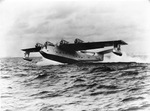PB2Y Coronado
| País | Estados Unidos |
| Fabricante | Consolidated Aircraft |
| Função Principal | Hidroavião |
| Primeiro Voo | 17 dez 1937 |
Contributor: C. Peter Chen
ww2dbasePB2Y Coronado flying boats were designed as the successor to the PBY Catalina flying boats. Orders for two prototype aircraft were placed in 1936, and the maiden flight took place in Dec 1937. After fixing stability issues with the prototype aircraft, the production design was designated PB2Y-2. PB2Y-3 variant design was completed shortly after the start of the Pacific War, which featured additional armor and self-sealing fuel tanks. In US Navy service, they saw both combat (bombing and anti-submarine warfare) and non-combat (transport and ambulance) roles, though the latter was much more commonplace. Ten PB2Y Coronado aircraft were also sent to the United Kingdom via the Lend Lease program; the British used them purely as transports, flying trans-Atlantic routes. Later in the war, despite engine upgrade and increased fuel capacity (PB2Y-5), the US Navy also relegated them to transport roles only. They were all scrapped shortly after WW2. During the design's production life, 217 examples were built.
ww2dbaseSource: Wikipedia
Last Major Revision: Jun 2011
PB2Y Coronado Timeline
| 17 dez 1937 | PB2Y Coronado flying boat took its first flight. |
SPECIFICATIONS
PB2Y-5
| Machinery | Four Pratt & Whitney R-1830-92 radial engines rated at 1,200hp each |
| Armament | 3x2x12.7mm M2 Browning machine guns in 3 turrets (nose, dorsal, tail), 2x12.7mm M2 Browning machine guns in waist mounts, 2 Mark 13 torpedoes or up to 5,400kg of bombs |
| Crew | 10 |
| Span | 35.00 m |
| Length | 24.20 m |
| Height | 8.40 m |
| Wing Area | 165.00 m² |
| Weight, Empty | 18,530 kg |
| Weight, Maximum | 30,000 kg |
| Speed, Maximum | 310 km/h |
| Speed, Cruising | 272 km/h |
| Service Ceiling | 6,250 m |
| Range, Normal | 1,720 km |
Photographs
 |  |  |  |
Você gostou deste artigo ou achou este artigo útil? Se sim, considere nos apoiar no Patreon. Qualquer valor já vai ajudar! Obrigado. Por favor, ajude-nos a divulgar o site: Fique atualizado com WW2DB: |
Visitor Submitted Comments
29 Jul 2012 01:58:00 PM
I've seen some sources state that the early Coronados were powered by Wright R-2600 engines and the re-powered with P&W 1830s. If this is true, does anyone know why?
4 May 2013 03:07:07 PM
Experimented with Wright Cyclone R-2600 in place of Pratt-Witney R-1830. They wanted to see if the
addional 500HP would be better. Wright 1700HP--PW1200HP. Didn't work out. Less maintence problems with PW Engines.
All visitor submitted comments are opinions of those making the submissions and do not reflect views of WW2DB.

- » Wreck of Teruzuki Found (27 jul 2025)
- » USS Orlean's Bow Found (22 jul 2025)
- » The Emperor of Japan Planned to Honor WW2-era Japanese POWs in Mongolia (4 jul 2025)
- » US State Lawmaker John Winter Caught Using Racial Slur "Jap" and Apologized (11 jun 2025)
- » US Government Plans to Purge WW2 Information (17 mar 2025)
- » Ver todas as notícias
- » 1,181 biografias
- » 337 eventos
- » 45,111 entradas na linha do tempo
- » 1,247 navios
- » 350 modelos de aeronaves
- » 207 modelos de veículos
- » 376 modelos de armas
- » 123 documentos históricos
- » 261 instalações
- » 470 resenhas de livros
- » 28,469 fotos
- » 365 mapas
Chiang Kaishek, 31 Jul 1937
Por favor, considere nos apoiar no Patreon. Mesmo R$1 por mês já faz uma grande diferença. Obrigado!
Ou, por favor, nos apoie adquirindo alguns produtos do WW2DB na TeeSpring. Obrigado!
19 Jun 2011 12:28:55 AM
The ten aircraft, designated PB2Y-3B. supplied to the RAF were based initially at Beaumaris, Anglesey, for service with Coastal Command. Their stay there was only brief, for they were transferred to No.231 Squadron of Transport Command and used from June 1944 to operate freight services.